Biological Control Methods for Cabbage Pests and Diseases
- Biological Control
-
- Commodity name: Biological Control Methods for Cabbage Pests and Diseases
Cabbage is a staple crop for many growers, but it is susceptible to a variety of pests and diseases that can significantly impact yield and quality. Common pests like cabbage loopers, cabbage aphids, and cabbage root fly can damage leaves and roots, reducing the plant’s ability to grow and produce heads. Diseases such as black rot, downy mildew, and cabbage clubroot further threaten the health of cabbage plants, causing stunted growth, leaf discoloration, and even plant death. Proper identification, monitoring, and management of these threats are crucial for ensuring a successful cabbage harvest. We’ll explore various cabbage pests and diseases in the article. Continue reading it.
Cabbage Pests
Cabbage Plant diseases
Cabbage Nutrition
Cabbage Pests
Aphids
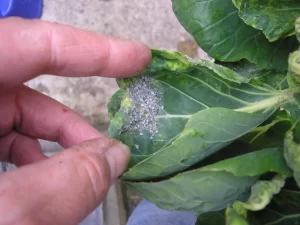
Features:
Cabbage Aphids are tiny insects that primarily feed on the sap of cabbage plants. They are typically green or black, but some species may exhibit different shades. Aphids tend to gather on the underside of cabbage leaves or around tender new shoots, forming dense clusters as they feed.
Symptoms:
Cabbage plants infested with cabbage aphids may exhibit several noticeable signs, including leaf curling, distortion, and yellowing. Aphids secrete honeydew, a sugary substance that can lead to the growth of sooty mold on cabbage leaves. This mold can hinder photosynthesis, affecting the plant’s growth and health.
Management:
Managing aphid infestations on cabbage involves biological control methods for cabbage pests. Encouraging natural predators, such as ladybugs and lacewings, can help keep aphid populations in check. Organic treatments like insecticidal soaps and neem oil can effectively reduce aphid numbers without causing harm to beneficial insects. Additionally, planting companion plants like marigolds can attract natural predators to the garden, offering a sustainable solution. Regular inspection of cabbage plants and prompt removal of heavily infested leaves can help prevent aphids from causing significant damage.
Solution:
A biological approach to cabbage aphid control, a common pest in cabbage plants, involves using natural, fungus-based solutions. Products like a generic Beaveria WP and Beauveria bassiana are effective biological controls for these pests. These fungi act as natural pathogens that infect and kill aphids without harming the cabbage plants or beneficial insects. When applied to the cabbage leaves or the surrounding soil, they help reduce aphid populations and protect your cabbage from damage.
Spider Mites
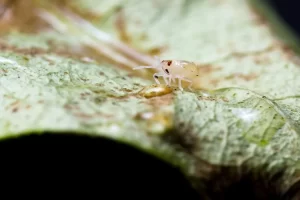
Features:
Spider mites are tiny arachnids that thrive in hot, dry conditions, making them common pests on cabbage plants. They are barely visible to the naked eye, often appearing as small red or brown dots. Spider mites weave fine, silk-like webs on the underside of leaves, which can help in identifying their presence.
Symptoms:
Cabbage plants infested with spider mites exhibit a range of symptoms, including yellowing or stippling on the leaves, which can progress to bronzing or browning if left unchecked. Heavy infestations can lead to leaf drop and reduced plant vigor, significantly impacting cabbage yields.
Management:
For biological control methods for cabbage pests, focus on maintaining adequate moisture levels around the plants to discourage mite proliferation. Natural predators like predatory mites and ladybugs can help keep spider mite populations in check. For chemical control, use insecticidal soaps or horticultural oils, but be sure to rotate treatments to prevent mite resistance. Regular monitoring and removing heavily infested leaves can also help prevent the spread of spider mites in the cabbage patch.
Solution:
A biological approach to managing spider mites, a common pest in cabbage plants, involves using natural, fungus-based solutions. A product like Beaveria WP is an effective biological control for these pests. This fungus acts as a natural pathogen that infects and kills spider mites without harming the cabbage plants or beneficial insects. When applied to the cabbage leaves, it helps reduce spider mite populations and protect your cabbage from damage.
Cucumber Beetles
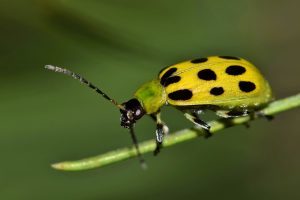
Features:
Cucumber beetles are small, elongated beetles that can be identified by their distinctive yellow and black stripes or spots. These beetles are common pests in a variety of vegetable crops, including cabbage. Adult beetles typically feed on the foliage, flowers, and stems of cabbage, while their larvae can cause root damage.
Symptoms:
Cucumber beetles on cabbage plants cause physical damage, including chewed or ragged leaves, holes in the foliage, and distorted plant growth. Larvae may damage roots, leading to weakened plants that are more susceptible to disease. The presence of cucumber beetles also increases the risk of transmitting bacterial wilt, a serious disease that can stunt or kill plants.
Management:
For biological control methods for cabbage pests, it requires a combination of cultural and chemical methods. Crop rotation helps reduce beetle populations, while row covers can protect young plants. Introducing natural predators, such as tachinid flies or nematodes, can also help control the beetles. Chemical control methods like insecticidal sprays should be used judiciously, as they can affect beneficial insects. Monitoring the plants regularly and removing adult beetles manually can prevent large infestations.
Solution:
For managing Cucumber Beetles, a common pest in cabbage plants, adopting a biological control strategy can be highly effective. Utilizing natural, fungus-based solutions such as a Myco Pestop and Metarhizium anisopliae provides a targeted approach to pest management. These products serve as natural pathogens, infecting and eliminating cucumber beetles while ensuring no harm to the cabbage, beneficial insects, or the environment. Application on cabbage leaves or directly to the soil can significantly reduce beetle populations, safeguarding your crops from damage.
Whiteflies
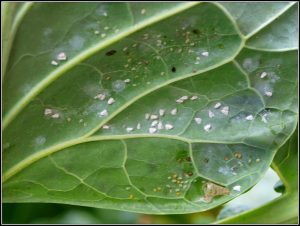
Features:
Cabbage maggot are commonly found on cabbage plants, often on the undersides of leaves. Despite their small size, they can reproduce rapidly and form dense colonies, making them a significant threat to cabbage crops.
Symptoms:
Whiteflies feed on plant sap, causing cabbage leaves to turn yellow, curl, or wilt. The honeydew they excrete can lead to the growth of sooty mold, which can cover the cabbage leaves and reduce their photosynthetic ability. In severe cases, whiteflies can weaken plants to the point of stunted growth and reduced crop yields.
Management:
Managing whiteflies on cabbage requires a multi-faceted approach. Natural predators such as ladybugs, lacewings, and parasitic wasps can help control whitefly populations. Insecticidal soaps, neem oil, and horticultural oils are also effective treatments. To prevent whitefly infestations, practice good crop rotation and avoid planting susceptible crops in the same area each season. Placing yellow sticky traps around cabbage fields can help monitor and control whiteflies by capturing them before they become a significant problem. Regular monitoring and early intervention are key to keeping whiteflies under control.
Solution:
A biological control methods for cabbage pests that are whiteflies, a frequent pest in cabbage crops, involves using natural, fungus-based solutions like a Beaveria WP . This product employs natural pathogens that specifically target and eliminate whiteflies without causing harm to the cabbage plants or beneficial insects in the environment. When this bioinsecticide is applied to the cabbage leaves, it effectively reduces the population of whiteflies, safeguarding your cabbage from the damage these pests can cause.
Thrips
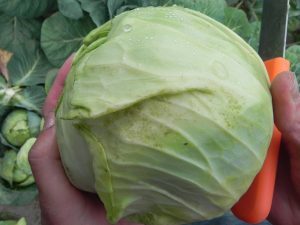
Features:
Thrips are tiny, slender insects with fringed wings. They are generally pale yellow or brown and range in size from 0.5 to 2.0 mm. Thrips often hide in the tight crevices between cabbage leaves or within the folds, making them difficult to detect.
Symptoms:
When thrips infest cabbage, they create characteristic silver streaks or patches on the leaves due to their feeding habits. This damage can lead to deformities, discoloration, and scarring, affecting the quality and marketability of the cabbage. Heavy infestations may cause leaf curling and stunted growth.
Management:
Effective management of thrips on cabbage includes introducing beneficial insects like minute pirate bugs, which prey on thrips. Another method is applying insecticidal soaps or horticultural oils, which disrupt their exoskeletons and control their numbers. For a preventative approach, practicing good field sanitation by removing plant debris can help reduce thrips’ breeding grounds. Companion planting with aromatic herbs like basil or dill can also deter thrips from infesting cabbage fields.
Solution:
A biological control methods for cabbage pests that is thrips, a frequent pest in cabbage crops, utilizes natural, fungus-based products to effectively control these pests. Solutions such as a Beaveria WP and Metarhizium anisopliae provide targeted pest control without causing harm to the cabbage or beneficial organisms in the environment. These biological agents work as natural pathogens, infecting and eliminating thrips through fungal infections. Application of these products directly onto cabbage leaves or surrounding soil can significantly decrease thrip populations and safeguard your crops from damage.
Flea Beetles

Features:
Flea beetles are tiny, shiny, metallic-colored beetles, often black or brown, that can jump like fleas when disturbed. These pests are common on cabbage and other cruciferous plants, typically feeding on the leaves. The adults create small holes resembling pinpricks, while larvae can feed on the roots.
Symptoms:
The primary symptom of flea beetle infestation is the presence of small, round holes on the cabbage leaves, creating a “shotgun” pattern. This feeding damage can reduce the plant’s vigor, affect its growth, and, in severe cases, cause leaf yellowing and premature dropping.
Management:
Managing flea beetles involves a combination of cultural and physical practices. Crop rotation and early planting can reduce flea beetle populations. Applying row covers can prevent beetles from reaching the plants, and sticky traps can help monitor their presence. Organic insecticides, such as pyrethrin or neem oil, may be used for heavy infestations. Encourage natural predators, like ground beetles and parasitic wasps, by maintaining a diverse garden environment with companion plants such as clover or yarrow.
Solution:
A biological control methods for cabbage pests that is Flea Beetles, a prevalent pest in cabbage plants, involves utilizing organic, fungus-based solutions. Products like a Myco Pestop and Metarhizium anisopliae are effective biological controls for these pests. These solutions work as natural pathogens, infecting and eliminating the beetles while being harmless to the cabbage plants and beneficial insects. Application on the cabbage leaves or directly into the surrounding soil can significantly reduce flea beetle populations and safeguard your cabbage from damage.
Leafhoppers cabbage pests
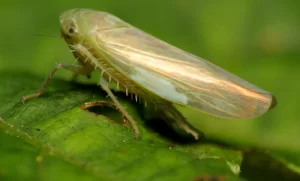
Features:
Leafhoppers are small, agile insects with slender bodies and wedge-shaped heads. They typically range in color from green to brown and are known for their ability to jump quickly when disturbed. Leafhoppers are often found on the leaves of cabbage plants, where they use their piercing mouthparts to suck plant sap.
Symptoms:
An infestation of leafhoppers on cabbage plants can lead to various symptoms, including stippling or tiny white spots on the leaves, leaf curling, and reduced plant vigor. The constant feeding by leafhoppers may cause significant stress on the cabbage plants, leading to stunted growth and, in severe cases, reduced crop yield. Additionally, leafhoppers can transmit plant pathogens, which may lead to further complications.
Management:
Managing leafhopper infestations in cabbage involves a combination of cultural, biological, and chemical strategies. Crop rotation and removing weeds and plant debris can reduce the habitat for leafhoppers. Encouraging natural predators such as spiders and parasitic wasps can help keep the population in check. If chemical control is necessary, insecticides specifically designed for leafhoppers should be used with caution, ensuring minimal impact on beneficial insects. Regular monitoring of cabbage plants for early signs of infestation is crucial for timely intervention and effective management.
Solution:
For managing leafhoppers, a troublesome pest in cabbage crops, a biological approach involves using specific, naturally-derived insecticides. A product such as BT Thuricide insecticide is an effective solution for controlling leafhoppers. This bacterium acts as a natural pathogen, selectively targeting leafhoppers and other pest insects while being safe for the cabbage plants and beneficial organisms. Application involves spraying the insecticide directly onto the cabbage leaves, where it is ingested by the pests, leading to their rapid decline without harmful residues.
Leafminers cabbage pests
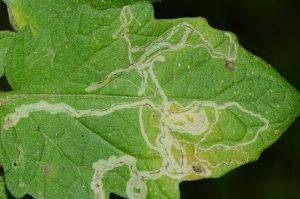
Features:
Leafminers are small, larvae-stage insects from the families Agromyzidae or Lepidoptera that burrow into the leaves of cabbage plants. They are typically tiny, with a variety of colors, ranging from pale yellow to dark brown. As they feed, they leave winding trails or “mines” within the leaf tissues.
Symptoms:
Cabbage plants infested with leafminers display visible signs of damage, such as winding, translucent trails that disrupt the leaf’s chlorophyll. These tunnels can coalesce, leading to significant leaf destruction, weakening the plant, and reducing its photosynthetic capacity. Severe infestations can lead to premature leaf drop or secondary infections.
Management:
To manage leafminers in cabbage plants, natural predators such as parasitic wasps and birds can help keep their populations in check. Covering plants with fine mesh or row covers can prevent adult flies from laying eggs. Insecticidal applications, like neem oil or spinosad, may be used, focusing on targeting larvae. Maintaining garden cleanliness and removing heavily infested leaves can reduce leafminer populations, preventing future outbreaks. Encouraging biodiversity in the garden with companion plants, like basil or marigolds, can help attract natural predators.
Solution:
For managing leafminers, a troublesome pest in cabbage plants, adopting a biological control method can be highly effective. The product, a BT Thuricide insecticide, targets these pests without causing harm to the cabbage or beneficial organisms in the environment. This natural bacterium works by producing a protein that, when ingested by the leafminers, disrupts their digestive systems, leading to their death. Application directly on the leaves where leafm
Diamondback Moth
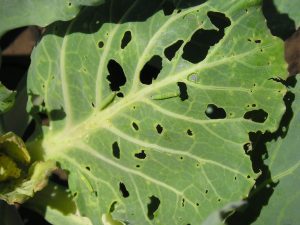
Features:
The Diamondback Moth (Plutella xylostella) is a small, grayish-brown moth whose larvae are notorious for feeding on cabbage plants. The larvae are pale green with a distinct tapered body and can grow up to 12 mm in length. They typically feed on the undersides of leaves, creating small, irregular holes and skeletonizing the foliage.
Symptoms:
Cabbage plants infested with Diamondback Moth larvae exhibit small, irregularly shaped holes in the leaves. Severe infestations can lead to extensive leaf damage, stunted growth, and reduced head formation. The larvae feed on the inner and outer leaves, which can lead to contamination and decreased market value.
Management:
To manage Diamondback Moths in cabbage plants, several strategies can be employed. Natural predators, such as parasitic wasps and birds, can help control their populations. Utilizing floating row covers can prevent adult moths from laying eggs on the plants. Insecticidal applications, such as neem oil or Bacillus thuringiensis (BT), can target larvae effectively. Regular monitoring and removing infested leaves can also help reduce their numbers. Encouraging biodiversity with companion plants like dill and cilantro can attract beneficial insects that prey on Diamondback Moth larvae.
Solution:
For biological control methods for cabbage pests that are Diamondback Moths, consider using a biological control product like BT Insecticide from NovoBac. This BT insecticide targets Diamondback Moth larvae without harming beneficial organisms or the cabbage plants. The bacterium Bacillus thuringiensis produces a protein that disrupts the digestive systems of the larvae when ingested, leading to their death. Apply the insecticide directly to the leaves where larvae are active to control the pest population and protect the health of your cabbage plants.
Squash Bugs
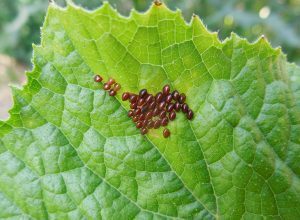
Features:
Squash bugs are large, oval-shaped insects that are generally gray or brown in color, with a flat back and noticeable antennae. Although they are typically associated with squash plants, they can occasionally attack cabbage. They often hide in crevices and beneath debris, making them difficult to detect. Squash bugs lay clusters of small, bronze-colored eggs on the undersides of leaves, which hatch into nymphs that resemble miniature versions of the adults.
Symptoms:
When squash bugs infest cabbage plants, they pierce the leaves to feed on the sap, leading to yellowing, cabbage wilting, and eventual death of the leaves. These feeding injuries can also make the plants more susceptible to secondary infections and disease. The presence of squash bugs can also result in distorted and stunted growth, ultimately affecting the overall health and productivity of cabbage crops.
Management:
For biological control methods for cabbage pests, that is Squash, start by removing debris and mulch from around the plants to reduce hiding spots. Hand-picking adults and nymphs, especially in the early morning when they are less active, can help control their numbers. Using row covers can prevent squash bugs from reaching the plants during their most vulnerable growth stages. Natural predators, like parasitic wasps, can help reduce squash bug populations. In severe cases, insecticidal soaps or neem oil may be used, but they should be applied with caution to avoid harming beneficial insects. Regularly inspecting the plants for egg clusters and removing them can also help prevent a large-scale infestation.
Solution:
For managing Squash Bugs, a troublesome pest in cabbage plants, consider employing natural, fungus-based biological solutions. Products like a Beaveria WP and Metarhizium anisopliae offer an effective means of biological control against these pests. These biocontrol agents utilize fungi that naturally infect and eliminate Squash Bugs, ensuring safety for the cabbage plants and the beneficial insects inhabiting your garden. Application of these products can be done directly on the affected plants or the surrounding soil to curb the Squash Bug population and safeguard your cabbages from damage.
Cutworms cabbage pests
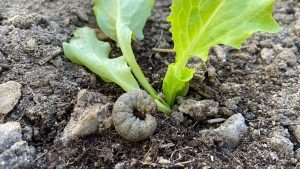
Features:
Cutworms are moth larvae, typically plump and smooth-skinned, that vary in color from gray to brown or black. They are nocturnal feeders, often hiding in soil during the day and emerging at night to feed on young cabbage plants. Cutworms are known for their tendency to cut through stems near the base of the plant.
Symptoms:
The most common symptom of cutworm damage in cabbage plants is the severed stems at or near the soil level. Young seedlings or transplants can be entirely cut down, leading to plant death. Additionally, cutworms can create small holes or notches on leaves as they feed, causing further damage.
Management:
To manage cutworm infestations in cabbage, use physical barriers like collars made of cardboard or plastic to protect young plants from being cut at the base. Crop rotation and removing plant debris can reduce the places where cutworms hide during the day. BT for cabbage worms larvae effectively. For severe infestations, apply chemical insecticides that specifically target cutworms while being cautious not to harm beneficial insects or contaminate the soil.
Solution:
Cabbage worm control involves using natural, fungus-based solutions. A product like Met Zone is effective for controlling these pests. This cabbage worm insecticide acts as a natural pathogen that specifically targets cutworms, infecting and eliminating them without harming the cabbage plants or beneficial insects. Application around the base of the cabbage plants can prevent cutworms from damaging the stems and roots, ensuring the healthy growth of your cabbages.
Stink Bugs
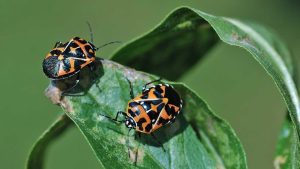
Features:
Stink bugs are shield-shaped insects with a distinctive triangular pattern on their backs. They come in various colors, including green, brown, and gray, and are known for the foul odor they release when disturbed or crushed. These bugs are often found on cabbage plants, especially during the warmer months.
Symptoms:
Stink bugs can cause significant damage to cabbage by piercing plant tissues with their needle-like mouthparts to feed on sap. This feeding activity can result in wilted leaves, brown spots, and a deformed cabbage head. Additionally, stink bugs may introduce pathogens into the plant, leading to secondary infections.
Management:
To control stink bugs in cabbage, you can attract beneficial insects like parasitic wasps and spiders that naturally prey on them. Physical barriers, such as row covers, can prevent stink bugs from reaching the plants. Hand-picking and destroying stink bugs can be effective for small infestations. For larger infestations, using targeted insecticides like pyrethroids may be necessary, but these should be applied carefully to minimize harm to beneficial insects. Regular monitoring and early detection can help manage stink bugs before they cause significant damage.
Solution:
A biological approach to managing Stink Bugs in cabbage plants utilizes natural, fungus-based solutions. Products such as a Beaveria WP and Metarhizium anisopliae are effective for controlling these pests. These fungi act as natural pathogens, infecting and killing Stink Bugs without causing harm to the cabbage plants or beneficial insects. Applying these products directly to the affected areas or the surrounding soil can significantly reduce Stink Bug populations and protect your cabbages.
Armyworms cabbage pests
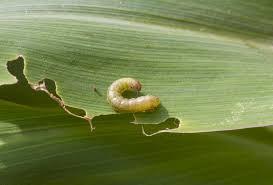
Features:
Armyworms are caterpillars from various moth species, characterized by their striped bodies and smooth skin. They can range in color from green to brown or black, often with distinctive markings or lines along their bodies. These pests are named for their behavior of marching across fields in large groups, devouring plants in their path.
Symptoms:
When armyworms infest cabbage plants, they cause significant damage by chewing large holes in the leaves, often consuming entire sections. The edges of the damaged leaves may appear ragged or uneven. In severe infestations, armyworms can defoliate whole plants, leading to reduced growth and crop yield.
Management:
To manage armyworms in cabbage, begin with regular monitoring for signs of their presence. Early detection and intervention are key to minimizing damage. Biological control methods, such as introducing natural predators like birds, beneficial wasps, or parasitic nematodes, can help reduce armyworm populations. Chemical controls, including insecticides with active ingredients like Bacillus thuringiensis (Bt) or spinosad, can be effective but should be used judiciously to avoid harming beneficial insects. Cultural practices such as crop rotation, maintaining healthy soil, and removing plant debris can also help prevent armyworm infestations.
Solution:
A biological approach to managing armyworms, a prevalent pest in cabbage crops, involves using targeted, natural solutions. BT Thuricide is a highly effective bioinsecticide against armyworms. This bacterium produces toxins that specifically target and kill caterpillars, including armyworms, without harming the cabbage plants or beneficial insects. When applied to cabbage leaves, Bt works by being ingested by the feeding armyworms, disrupting their digestive systems and leading to their elimination. This method not only reduces armyworm populations but also preserves the overall health of your cabbage crop.
Cabbage Plant diseases
Black Rot
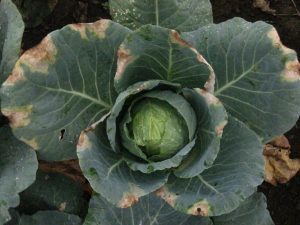
Features:
Black Rot, caused by the bacterium Xanthomonas campestris pv. campestris, is a destructive disease affecting cabbage plants. It is characterized by its ability to survive in plant debris and soil, making it a persistent threat in areas with warm and humid climates.
Symptoms:
Black Rot manifests initially as V-shaped lesions on the margins of cabbage leaves, starting from the leaf edge and progressing inward. These lesions have a characteristic yellow halo surrounding them. As the disease advances, the lesions expand, turning brown to black in color, and causing the affected leaves to become dry and brittle. Infected plants may exhibit cabbage wilting, stunted growth, and premature leaf drop. Additionally, dark streaks may develop in the vascular tissues of the cabbage head.
Management:
Effective management of Black Rot in cabbage involves implementing cultural and preventive measures. Rotate cabbage crops with non-host plants to reduce the buildup of pathogen inoculum in the soil. Plant certified disease-free seeds or transplants to minimize initial infection. Maintain proper spacing between plants to improve air circulation and reduce humidity around the cabbage heads. Remove and destroy infected plant debris to prevent the spread of the bacterium. Avoid overhead irrigation to minimize moisture on foliage, as the bacterium spreads through water splashing. Copper-based fungicides or bactericides can be applied preventively, especially during periods of high disease pressure, but ensure proper timing and coverage for effective control. Early detection through regular scouting and prompt removal of infected plants can help contain the spread of Black Rot within the cabbage crop.
Solution:
A biological approach to managing black rot, a prevalent disease in cabbage crops, involves using targeted, natural solutions. Bacillus subtilis fungicide and Bacillus amyloliquefaciens are highly effective against black rot. These beneficial bacteria produce compounds that inhibit the growth of Xanthomonas campestris, the pathogen responsible for black rot, without harming the cabbage plants or beneficial microorganisms. When applied to cabbage leaves, these bacteria colonize the plant surface, creating a protective barrier and producing antimicrobial substances that prevent the pathogen from establishing. This method not only controls black rot but also supports the overall health of your cabbage crop, ensuring a robust and disease-free harvest.
Clubroot Cabbage Diseases and Control
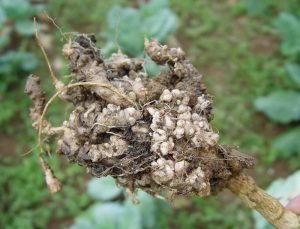
Features:
Cabbage Clubroot, caused by the soil-borne pathogen Plasmodiophora brassicae, is a serious disease affecting cabbage plants. It primarily manifests as swollen, club-like growths on the roots of infected plants, hence the name “clubroot.”
Symptoms:
Initial symptoms of Clubroot include stunted growth and yellowing of leaves, often resembling symptoms of nutrient deficiency. As the disease progresses, the roots become distorted and swollen, forming club-shaped galls. Infected plants may exhibit cabbage wilting, especially during periods of heat or drought stress. Severe infestations can lead to plant death and significant yield losses.
Management:
Managing Clubroot in cabbage plants involves several strategies. Firstly, practice crop rotation with non-cruciferous crops to reduce the buildup of the pathogen in the soil. Choose resistant cabbage varieties when available, as they can help mitigate the impact of the disease. Improve soil drainage to prevent waterlogging, as Clubroot thrives in wet conditions. Use raised beds or containers in areas with poorly draining soil. Additionally, sanitize gardening tools and equipment to prevent the spread of the pathogen between plants. If Clubroot is already present, remove and destroy infected plant debris to reduce inoculum levels in the soil. Soil solarization can also be effective in killing Clubroot spores in the soil.
Solution:
A biological approach to managing clubroot, a prevalent disease in cabbage crops, involves using targeted, natural solutions. Trianum Shield and Trichoderma harzianum are highly effective biofungicides against clubroot. These beneficial fungi colonize the root zone, creating a protective barrier that inhibits the growth of Plasmodiophora brassicae, the pathogen responsible for clubroot. When applied to the soil, these fungi work by outcompeting the pathogen for nutrients and space, effectively reducing its impact. This method not only controls clubroot but also enhances the overall health of your cabbage crop by promoting beneficial microbial activity in the soil.
Downy Mildew

Features:
Downy Mildew, caused by the oomycete pathogen Peronospora parasitica, is a fungal-like disease commonly affecting cabbage plants, especially in cool, moist conditions. It is characterized by the presence of fuzzy, downy growth on the undersides of leaves, which may appear yellow or chlorotic on the upper surface.
Symptoms:
Initial signs of Downy Mildew on cabbage plants include the development of yellow or pale green patches on the upper surface of leaves. As the disease progresses, these patches may become angular and spread, eventually turning brown or necrotic. On the undersides of infected leaves, a grayish-purple downy growth may develop, particularly in humid conditions. Severe infections can lead to leaf distortion, wilting, and premature defoliation, ultimately reducing plant vigor and yield.
Management:
Effective management of Downy Mildew in cabbage plants relies on preventive measures and cultural practices. Planting resistant varieties can help reduce the risk of infection. Proper spacing between plants promotes air circulation and reduces humidity, minimizing favorable conditions for disease development. Avoiding overhead irrigation and watering plants at the base can help prevent the spread of spores. Regular removal and disposal of infected plant debris reduce the inoculum source. Fungicidal sprays containing active ingredients such as copper-based compounds or mancozeb can be applied preventatively or curatively, following label instructions carefully to minimize environmental impact and resistance development. Additionally, rotation with non-host crops and maintaining a clean planting area can help break the disease cycle. Early detection through regular scouting and prompt intervention are essential for effective management of Downy Mildew in cabbage crops.
Solution:
A biological approach to managing downy mildew, a common disease in cabbage crops, involves using targeted, natural solutions. Trianum-V is a highly effective natural fungicide against downy mildew. This product contains beneficial fungi that combat harmful pathogens, including the ones causing downy mildew, without harming the cabbage plants or beneficial organisms. When applied to cabbage plants, Trianum-V works by colonizing the root zone and creating a protective barrier, which prevents the establishment and spread of the mildew pathogen. This method not only reduces downy mildew infections but also promotes the overall health and vigor of your cabbage crop.
Fusarium Wilt cabbage plant diseases
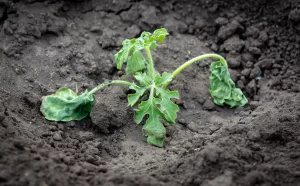
Features:
Fusarium Wilt, caused by the soil-borne fungus Fusarium oxysporum, is a destructive disease affecting cabbage plants. The fungus infects the vascular system of the plant, leading to wilting and stunted growth.
Symptoms:
Initially, Fusarium Wilt may cause yellowing and wilting of lower leaves, which gradually progresses upward in the plant. The affected leaves may become necrotic, and the entire plant may wilt during the day, recovering slightly at night. Upon inspection, brown discoloration of the vascular tissues can be observed. In severe cases, the cabbage plant may die prematurely.
Management:
Management of Fusarium Wilt involves preventive measures and cultural practices. Use certified disease-free seeds and practice crop rotation to reduce the buildup of pathogen inoculum in the soil. Avoid planting cabbage in fields with a history of Fusarium Wilt. Ensure proper drainage to prevent waterlogging, as the fungus thrives in moist conditions. Solarization of soil can help reduce fungal populations. There are no chemical treatments available for Fusarium Wilt in cabbage. Therefore, focus on cultural practices and resistant varieties to mitigate the impact of the disease.
Solution:
A biological approach to managing Fusarium Wilt, a devastating disease in cabbage crops, involves using targeted, natural solutions. Trianum Shield is a highly effective biofungicide against Fusarium Wilt. This beneficial fungus, Trichoderma harzianum, colonizes the root zone of cabbage plants, creating a protective barrier that suppresses the Fusarium pathogen. When applied to the soil or plant roots, Trianum Shield enhances root growth and boosts the plant’s natural defenses. This method not only controls Fusarium Wilt but also promotes overall plant health and vigor, ensuring a more resilient and productive cabbage crop.
Alternaria Leaf Spot in cabbage
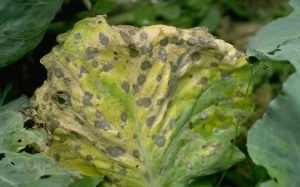
Features:
Alternaria Leaf Spot, caused by the fungus Alternaria brassicicola, is a common disease affecting cabbage plants, especially in warm and humid conditions. It is characterized by the appearance of dark, concentric rings with a bull’s-eye pattern on the leaves.
Symptoms:
Initially, small, dark brown or black spots develop on the older leaves of cabbage plants. These spots gradually enlarge and may coalesce, forming larger lesions with a concentric ring pattern. As the disease progresses, the affected leaves may yellow and eventually wither and die. In severe cases, Alternaria Leaf Spot can lead to defoliation, reducing the plant’s photosynthetic capacity and overall yield.
Management:
To manage Alternaria Leaf Spot in cabbage plants, employ cultural and chemical control methods. Cultural practices include crop rotation with non-host plants, such as corn or beans, to reduce the buildup of fungal spores in the soil. Adequate spacing between plants promotes air circulation and reduces humidity around the leaves, inhibiting fungal growth. Remove and destroy infected plant debris to prevent the spread of the disease.
Solution:
A biological approach to managing Alternaria Leaf Spot, a common disease in cabbage crops, involves using targeted, natural solutions. Trianum-V is a highly effective natural fungicide against Alternaria Leaf Spot. This product contains beneficial fungi that specifically target and suppress fungal pathogens, including Alternaria species, without harming the cabbage plants or beneficial microorganisms. When applied to cabbage leaves, Trianum-V works by colonizing the plant surface and creating a protective barrier, preventing the fungal spores from infecting the plant. This method not only reduces Alternaria Leaf Spot but also preserves the overall health of your cabbage crop.
Anthracnose
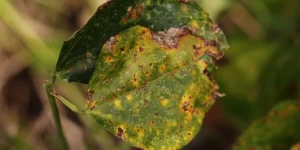
Features:
Anthracnose, caused by the fungus Colletotrichum spp., is a fungal disease that commonly affects cabbage plants. It is characterized by the development of dark, sunken lesions on various parts of the plant, including leaves, stems, and sometimes even the heads of cabbage. These lesions may initially appear water-soaked and small, but they gradually enlarge and become dark brown to black in color. Anthracnose can lead to significant yield losses if not properly managed.
Symptoms:
Symptoms of Anthracnose in cabbage typically start as small, circular lesions on the leaves, which may have a water-soaked appearance. As the disease progresses, these lesions enlarge and darken, often becoming sunken and surrounded by a reddish-brown margin. In severe cases, the lesions can coalesce, causing extensive damage to the foliage and reducing the overall vigor of the plant. Infected cabbage heads may also develop lesions, which can lead to premature rotting and loss of marketable quality.
Management:
To manage Anthracnose in cabbage plants, it is essential to employ a combination of cultural and chemical control measures. Cultural practices that promote plant health and reduce the spread of the fungus include crop rotation, proper spacing between plants to ensure adequate airflow, and removal and destruction of infected plant debris. Avoid overhead irrigation to minimize moisture on the leaves, as wet conditions can promote disease development.
Solution:
A biological approach to managing anthracnose, a common disease in cabbage crops, involves using targeted, natural solutions. Trianum Shield is a highly effective biofungicide against anthracnose. This product contains Trichoderma harzianum, a beneficial fungus that colonizes plant roots and stimulates the plant’s natural defenses. When applied to cabbage plants, Trianum Shield works by outcompeting the pathogenic fungi, inhibiting their growth, and promoting healthier root systems. This method not only controls anthracnose but also enhances the overall health and resilience of your cabbage crop.
Powdery Mildew cabbage plant diseases
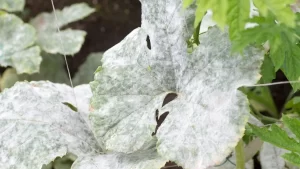
Features:
Powdery Mildew is a fungal disease commonly affecting cabbage plants, caused by various species of the Erysiphales order. It manifests as a powdery white or grayish coating on the surfaces of leaves, stems, and sometimes even the heads of cabbage.
Symptoms:
The initial signs of Powdery Mildew on cabbage plants include the appearance of white or grayish patches on the upper surfaces of leaves. These patches gradually enlarge and may cover the entire leaf, giving it a powdery or flour-like appearance. Infected leaves may become distorted or curled, and severe infestations can lead to premature leaf drop. In advanced stages, the mildew may spread to stems and cabbage heads, affecting their growth and quality.
Management:
To manage Powdery Mildew in cabbage plants, cultural practices play a significant role. Start with selecting disease-resistant cabbage varieties when possible. Ensure proper spacing between plants to promote air circulation and reduce humidity levels. Avoid overhead watering, as wet foliage can encourage fungal growth; instead, use drip irrigation or water at the base of plants. Regularly remove and dispose of infected plant debris to prevent the spread of spores. Fungicidal sprays containing active ingredients such as sulfur, potassium bicarbonate, or neem oil can be used to control Powdery Mildew, but follow label instructions carefully and rotate between different modes of action to prevent resistance buildup. Additionally, applying a layer of mulch around plants can help prevent spores from splashing onto leaves and stems. Regular monitoring and early intervention are essential for effectively managing Powdery Mildew in cabbage crops.
Solution:
A biological approach to managing powdery mildew, a common disease in cabbage crops, involves using targeted, natural solutions. Trianum-V is a highly effective natural fungicide against powdery mildew. This product contains beneficial fungi that specifically target and control powdery mildew without harming the cabbage plants or beneficial organisms. When applied to cabbage leaves, Trianum-V works by colonizing the plant surface and creating a protective barrier against the mildew, disrupting its growth and spread. This method not only reduces powdery mildew infections but also preserves the overall health of your cabbage crop.
Rhizoctonia Rot Cabbage Diseases and Control

Features:
Rhizoctonia Rot, caused by the fungus Rhizoctonia solani, is a common disease affecting cabbage plants, particularly in warm and humid conditions. The fungus infects cabbage plants through wounds or soil contact and thrives in poorly drained soils with organic debris.
Symptoms:
Initial signs of Rhizoctonia Rot on cabbage plants include the appearance of water-soaked lesions at the base of the plant or on the lower leaves. These lesions may initially be small and brown but can rapidly expand, causing wilting and collapse of the affected tissues. As the disease progresses, the lesions may become sunken and dark brown to black in color. Infected plants may exhibit stunted growth and ultimately die if the infection is severe.
Management:
To manage Rhizoctonia Rot in cabbage plants, cultural practices that promote plant vigor and reduce moisture stress are essential. Plant cabbage in well-drained soils and avoid overwatering to minimize favorable conditions for fungal growth. Practice crop rotation to reduce the buildup of fungal inoculum in the soil. Remove and destroy infected plant debris to prevent the spread of the disease. Fungicidal treatments containing active ingredients such as thiophanate-methyl or azoxystrobin may be applied preventatively to protect healthy plants, but proper application timing and coverage are crucial for effectiveness. Additionally, maintaining proper plant spacing to encourage air circulation can help reduce humidity levels and limit fungal spread. Regular monitoring of plants for early signs of disease and prompt intervention are key to managing Rhizoctonia Rot effectively.
Solution:
A biological approach to managing Rhizoctonia Rot, a common disease in cabbage crops, involves using targeted, natural solutions. Trianum Shield is a highly effective biofungicide against Rhizoctonia Rot. This product contains beneficial fungi that combat the Rhizoctonia pathogens by colonizing the root zone and outcompeting harmful organisms. When applied to the soil around cabbage plants, Trianum Shield works by enhancing root health and creating a protective barrier, preventing the disease from taking hold. This method not only reduces Rhizoctonia Rot but also promotes the overall health and vigor of your cabbage crop.
Sclerotinia Rot
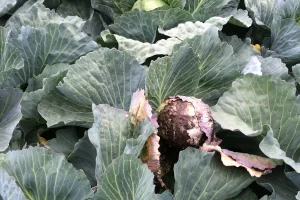
Features:
Sclerotinia Rot, caused by the fungus Sclerotinia sclerotiorum, is a fungal disease that commonly affects cabbage plants, especially in cool and moist conditions. It is characterized by the formation of hard, black fungal structures called sclerotia, which survive in the soil and plant debris, contributing to the disease’s persistence.
Symptoms:
Initial signs of Sclerotinia Rot on cabbage plants include water-soaked lesions on leaves and stems, which rapidly expand and become soft and mushy. As the disease progresses, white cottony growth may appear on the affected tissues. Infected areas eventually collapse, forming sunken lesions. Sclerotia may develop within the lesions and spread to nearby plants, leading to cabbage wilting and death of the entire plant.
Management:
To manage Sclerotinia Rot in cabbage plants, implement cultural practices that reduce moisture and limit the spread of the fungus. Rotate cabbage crops with non-host plants to disrupt the disease cycle. Practice proper sanitation by removing and destroying infected plant debris to reduce the inoculum in the soil. Ensure adequate spacing between plants to promote air circulation and reduce humidity around the foliage. Fungicidal applications containing active ingredients like boscalid or fluazinam may be effective in preventing the disease, especially when applied preventatively during periods of high risk. Additionally, planting resistant cabbage varieties can help mitigate the impact of Sclerotinia Rot. Regular monitoring and early detection of symptoms are crucial for effective management.
Solution:
A biological approach to managing Sclerotinia rot, a common disease in cabbage crops, involves using targeted, natural solutions. Trianum Shield and Trichoderma harzianum are highly effective biocontrol agents against Sclerotinia rot. These beneficial fungi colonize the root zone and plant surface, outcompeting the harmful pathogens and producing enzymes that degrade the Sclerotinia fungus. When applied to cabbage plants, they create a protective barrier and promote overall plant health by enhancing nutrient uptake and resistance to diseases. This method not only controls Sclerotinia rot but also supports a robust and healthy cabbage crop.
White Mold
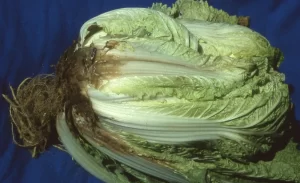
Features:
White Mold, also known as Sclerotinia Rot, is a fungal disease caused by the pathogen Sclerotinia sclerotiorum. It commonly affects cabbage plants, especially in cool and moist conditions. The disease earns its name from the white, fluffy mycelium and the small, hard, black sclerotia structures it produces on infected tissues.
Symptoms:
Initial symptoms of White Mold on cabbage plants include water-soaked lesions on leaves, which gradually expand and become white, fluffy masses of fungal growth. Infected leaves may wilt and die off, and the fungus can spread to stems and eventually to the head of the cabbage. The disease progresses with the formation of black sclerotia, which can survive in the soil and infect subsequent crops.
Management:
Effective management of White Mold in cabbage plants involves several strategies. Ensure proper spacing between plants to improve air circulation and reduce humidity levels. Avoid overhead irrigation to minimize moisture on foliage, as damp conditions favor fungal development. Regularly remove and destroy infected plant debris to reduce the inoculum source. Crop rotation with non-host plants can help break the disease cycle. Fungicides containing active ingredients like boscalid or fluazinam may be applied preventatively, but their effectiveness can vary, and they should be used in combination with cultural practices for best results.
Solution:
A biological approach to managing white mold in cabbage crops involves using Novobac’s natural fungicide, Trianum-V. This biofungicide, containing Trichoderma harzianum, creates a protective barrier on plant surfaces and roots, effectively inhibiting white mold pathogens. By outcompeting harmful fungi and promoting plant defense mechanisms, Trianum-V ensures healthier cabbage plants and reduces white mold infections. This eco-friendly method enhances crop resilience without harmful residues, supporting sustainable agriculture practices.
Bacterial Soft Rot cabbage plant diseases
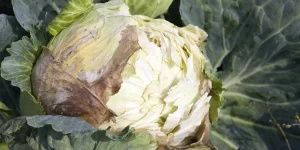
Features:
Bacterial Soft Rot is a destructive disease of cabbage caused by various bacterial pathogens, including Pectobacterium carotovorum and Erwinia spp. It is favored by warm and humid conditions and often occurs during periods of high rainfall or irrigation.
Symptoms:
Bacterial Soft Rot typically starts as water-soaked lesions on cabbage heads or leaves, which quickly become slimy and develop into soft, mushy areas. The affected tissues may emit a foul odor as they decay. As the disease progresses, the entire cabbage head can collapse, leading to extensive rotting and rendering the crop unmarketable.
Management:
Effective management of Bacterial Soft Rot in cabbage involves several strategies. Firstly, practice crop rotation to reduce the buildup of bacterial pathogens in the soil. Plant cabbage in well-drained soil and avoid excessive moisture, as soggy conditions create an ideal environment for bacterial proliferation. Remove and destroy infected plants promptly to prevent the spread of the disease to healthy crops. Additionally, employ cultural practices such as spacing plants adequately to improve air circulation and minimize leaf wetness. Copper-based bactericides can be applied preventatively to protect healthy plants, but they may have limited efficacy once symptoms appear. As with any disease management strategy, early detection and intervention are crucial for minimizing crop losses.
Solution:
A biological approach to managing bacterial soft rot in cabbage crops involves using Novobac’s bactericide, Bactonus. This product contains Bacillus safensis, Bacillus velezensis, and Pseudomonas chlororaphis, which colonize plant roots and produce antimicrobial compounds that inhibit pathogenic bacteria. These beneficial bacteria create a protective barrier on plant surfaces, preventing infections and promoting healthier plants. This method effectively controls bacterial soft rot and enhances the overall health and resilience of your cabbage crop.
Cabbage Ring Spot cabbage diseases

Features:
Cabbage Ring Spot, caused by the fungus Mycosphaerella brassicicola, is a prevalent disease affecting cabbage plants, particularly in humid and warm conditions. It earns its name from the circular or irregular spots with dark centers and yellow halos that develop on infected leaves.
Symptoms:
Initially, small, water-soaked lesions appear on cabbage leaves, typically near the margins. These lesions gradually enlarge, forming distinct rings with dark centers and yellowish halos. As the disease progresses, the spots coalesce, leading to extensive tissue damage and eventual leaf yellowing and defoliation. In severe cases, the infection can spread to cabbage heads, causing blemishes and reducing marketability.
Management:
Effective management of Cabbage Ring Spot involves implementing cultural and chemical control measures. Rotate cabbage crops with non-cruciferous plants to reduce pathogen buildup in the soil. Practice good sanitation by removing and destroying infected plant debris to limit overwintering sources of the fungus. Adequate spacing between plants promotes air circulation and reduces humidity, minimizing favorable conditions for disease development. Fungicidal sprays containing active ingredients like chlorothalonil or mancozeb can be applied preventively or at the first sign of symptoms to protect healthy foliage. Follow label instructions carefully and rotate fungicides with different modes of action to mitigate the risk of resistance development. Early detection through regular scouting and prompt intervention are crucial for effective management of Cabbage Ring Spot.
Solution:
A biological approach to managing cabbage ring spot, a common disease affecting cabbage crops, involves using targeted, natural solutions like Novobac’s Trianum Shield. This product, containing Trichoderma harzianum, is an effective biofungicide against cabbage ring spot. It colonizes the root zone and leaf surfaces, outcompeting pathogenic fungi and creating a protective barrier. By promoting healthy root growth and stimulating the plant’s natural defenses, Trianum Shield controls cabbage ring spot and enhances the overall resilience and health of your cabbage crop.
Xanthomonas Leaf Spot cabbage plant diseases
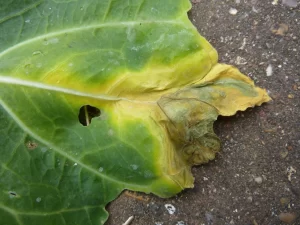
Features:
Xanthomonas Leaf Spot, caused by the bacterium Xanthomonas campestris pv. campestris, is a common disease affecting cabbage plants. It is characterized by the presence of small, water-soaked lesions on the leaves, which later turn necrotic, often with yellow halos surrounding the spots.
Symptoms:
Initial signs of Xanthomonas Leaf Spot on cabbage plants include the appearance of tiny, dark green to black lesions on the leaves. These lesions gradually enlarge and develop into irregularly shaped spots with a water-soaked appearance. As the disease progresses, the spots turn necrotic, forming dry, brown to black lesions with yellow halos. Severe infections can cause leaf wilting and defoliation, leading to reduced plant vigor and yield.
Management:
To manage Xanthomonas Leaf Spot in cabbage plants, it is crucial to practice good sanitation measures. Remove and destroy infected plant debris to reduce the source of inoculum. Rotate crops to prevent the buildup of bacteria in the soil. Avoid overhead irrigation to minimize the spread of bacteria through splashing water. Copper-based fungicides or bactericides can be applied preventatively or at the first signs of disease to help control the spread, but be cautious to follow label instructions to avoid phytotoxicity. Additionally, planting disease-resistant cabbage varieties can help reduce the impact of Xanthomonas Leaf Spot. Regular monitoring and prompt action are essential for effective management of this disease.
Solution:
A biological approach to managing Xanthomonas Leaf Spot, a common disease in cabbage crops, involves using targeted, natural solutions. Bacillus subtilis is a highly effective biofungicide against Xanthomonas Leaf Spot. This bacterium produces antibiotics and enzymes that specifically target and suppress the pathogen, without harming the cabbage plants or beneficial microorganisms. When applied to cabbage leaves, Bacillus subtilis works by colonizing the leaf surface, outcompeting the harmful bacteria and preventing infection. This method not only reduces Xanthomonas Leaf Spot occurrences but also preserves the overall health of your cabbage crop.
Verticillium Wilt cabbage diseases
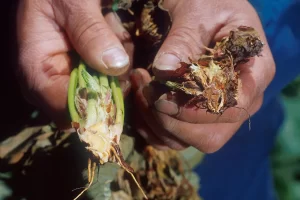
Features:
Verticillium Wilt, caused by the fungus Verticillium spp., is a fungal disease commonly affecting cabbage plants. The fungus can survive in the soil for several years, making it a persistent threat to cabbage crops. It infects plants through the roots and colonizes the vascular system, restricting water flow and nutrient uptake.
Symptoms:
Initial symptoms of Verticillium Wilt on cabbage plants include wilting and yellowing of lower leaves, often starting on one side of the plant. As the disease progresses, wilting spreads upward, affecting more leaves and eventually the entire plant. Leaves may develop brown or necrotic spots, and the vascular tissue may show dark discoloration upon cutting the stem. In severe cases, plants may exhibit stunted growth and premature senescence.
Management:
Managing Verticillium Wilt in cabbage plants involves several strategies. Start by planting resistant varieties whenever possible. Rotate cabbage crops with non-host plants to reduce pathogen buildup in the soil. Avoid planting cabbage in fields with a history of Verticillium Wilt or where susceptible crops have been grown recently. Practice good sanitation by removing and destroying infected plant debris. Ensure proper irrigation practices to prevent water stress, as stressed plants are more susceptible to infection. Fungicide applications may provide limited control but are generally not considered effective for managing Verticillium Wilt in cabbage.
Solution:
A biological approach to managing Verticillium wilt, a challenging disease in cabbage crops, involves using targeted, natural solutions. One highly effective method is applying an organic fungicide or cropium. This product combats the Verticillium fungus without harming the cabbage plants or beneficial soil microorganisms. When applied to the soil and plant roots, the organic fungicide works by inhibiting the growth and spread of the Verticillium fungus, effectively protecting the cabbage plants from infection. This method not only controls Verticillium wilt but also supports the overall health of your cabbage crop.
Nutrition Management in Organic Cabbage
Nutrition management as to how to grow organic cabbage is crucial for achieving healthy, robust growth and high yields. Organic cabbage relies on nutrient-rich, well-maintained soil, which can be achieved through the use of organic fertilizers, compost, and cover crops. Regular applications of compost enrich the soil with essential nutrients like nitrogen, phosphorus, and potassium, while also improving soil structure and water retention.
Incorporating green manures and cover crops, such as clover or legumes, can enhance soil fertility by fixing nitrogen and adding organic matter. Additionally, rotating crops and practicing intercropping can help prevent nutrient depletion and reduce pest and disease pressures. By focusing on soil health and using sustainable practices, organic cabbage growers can ensure their crops receive balanced nutrition, leading to vigorous plant growth and superior quality produce.
In addition, products like Soil Vigor from Novobac help break down organic matter and release trapped nutrients, enhancing soil fertility.
Soil Amendment and Growth Stimulation
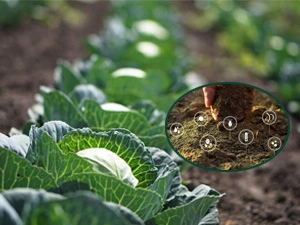
“Soil Vigor” refers to the dynamic and healthy state of soil, enriched through the amendment of microorganisms which play a crucial role in enhancing plant growth. The introduction of beneficial microorganisms into the soil ecosystem fosters a symbiotic relationship with plant roots, improving nutrient uptake and resilience against diseases. These microorganisms, including bacteria, fungi, and archaea, decompose organic matter, releasing essential nutrients like nitrogen, phosphorus, and potassium back into the soil, making them readily available for plants. Additionally, they improve soil structure, enhance water retention, and stimulate root growth through the production of growth-promoting substances. This biological approach not only boosts plant vigor and productivity but also promotes sustainable and environmentally friendly farming practices by reducing the need for chemical fertilizers and pesticides.
Phosphorus for Cabbage
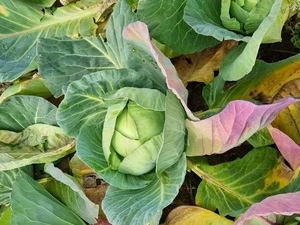
Cropium aids in phosphorus solubilization, making phosphorus more available to plants.
It is a cutting-edge agricultural solution designed to enhance crop growth by promoting the absorption of inorganic phosphorus from the soil. Inorganic phosphorus is a critical nutrient for plant development, playing a vital role in energy transfer, photosynthesis, and the synthesis of nucleic acids. However, phosphorus availability in soil is often limited due to its tendency to form insoluble compounds. Cropium addresses this challenge by facilitating the uptake of phosphorus, ensuring that crops receive adequate amounts of this essential nutrient. This not only boosts crop yield and quality but also contributes to more sustainable farming practices by optimizing nutrient use efficiency and reducing the need for phosphorus-based fertilizers. Through its innovative approach, Cropium supports farmers in achieving higher productivity and healthier crops, ultimately leading to more resilient agricultural systems.
Nitrogen for Cabbage
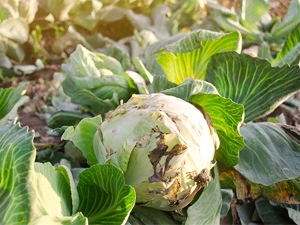
Metilo promotes nitrogen fixation, converting atmospheric nitrogen into forms usable by plants. These biological strategies not only protect cabbage crops but also promote a healthier ecosystem, supporting long-term agricultural sustainability. Metilo is an innovative agricultural solution designed to enhance crop growth by promoting nitrogen fixation. Nitrogen fixation is a crucial process where atmospheric nitrogen is converted into a form that plants can absorb and utilize for growth. By boosting this process, Metilo helps crops efficiently acquire the necessary nitrogen, leading to improved health and productivity. This advancement not only supports robust plant development but also contributes to sustainable farming practices by reducing the reliance on synthetic nitrogen fertilizers. Consequently, Metilo plays a significant role in increasing crop yields and fostering environmentally friendly agricultural practices.
Biological Solutions for Organic Cabbage Pests,Diseases, and Nutrients Management
Biological solutions offer significant benefits for managing cabbage diseases and pests, playing a crucial role in sustainable agriculture. Utilizing natural antagonists and beneficial organisms, such as Trichoderma spp. and predatory insects, enhances disease control and pest management while improving soil health. These eco-friendly methods reduce the need for chemical pesticides, promoting healthier ecosystems and safer produce.
Managing pests, diseases, and nutrients in organic cabbage cultivation requires a holistic approach that emphasizes sustainability and ecological balance. Biological solutions play a crucial role in this process. For pest control, beneficial insects like ladybugs, lacewings, and parasitic wasps can naturally reduce populations of harmful pests such as aphids, cabbage loopers, and diamondback moths.Utilizing biopesticides like Bacillus thuringiensis (BT) effectively targets specific pests without harming beneficial organisms or the environment. Disease management involves promoting healthy soil through crop rotation, composting, and the use of disease-resistant cabbage varieties. To ensure optimal nutrient availability, organic fertilizers such as compost, green manures, and bone meal provide essential nutrients while improving soil structure and fertility.
Adopting these practices not only protects the environment but also supports long-term agricultural productivity, potentially revolutionizing gardening and farming by fostering robust, resilient crops and reducing ecological impact.
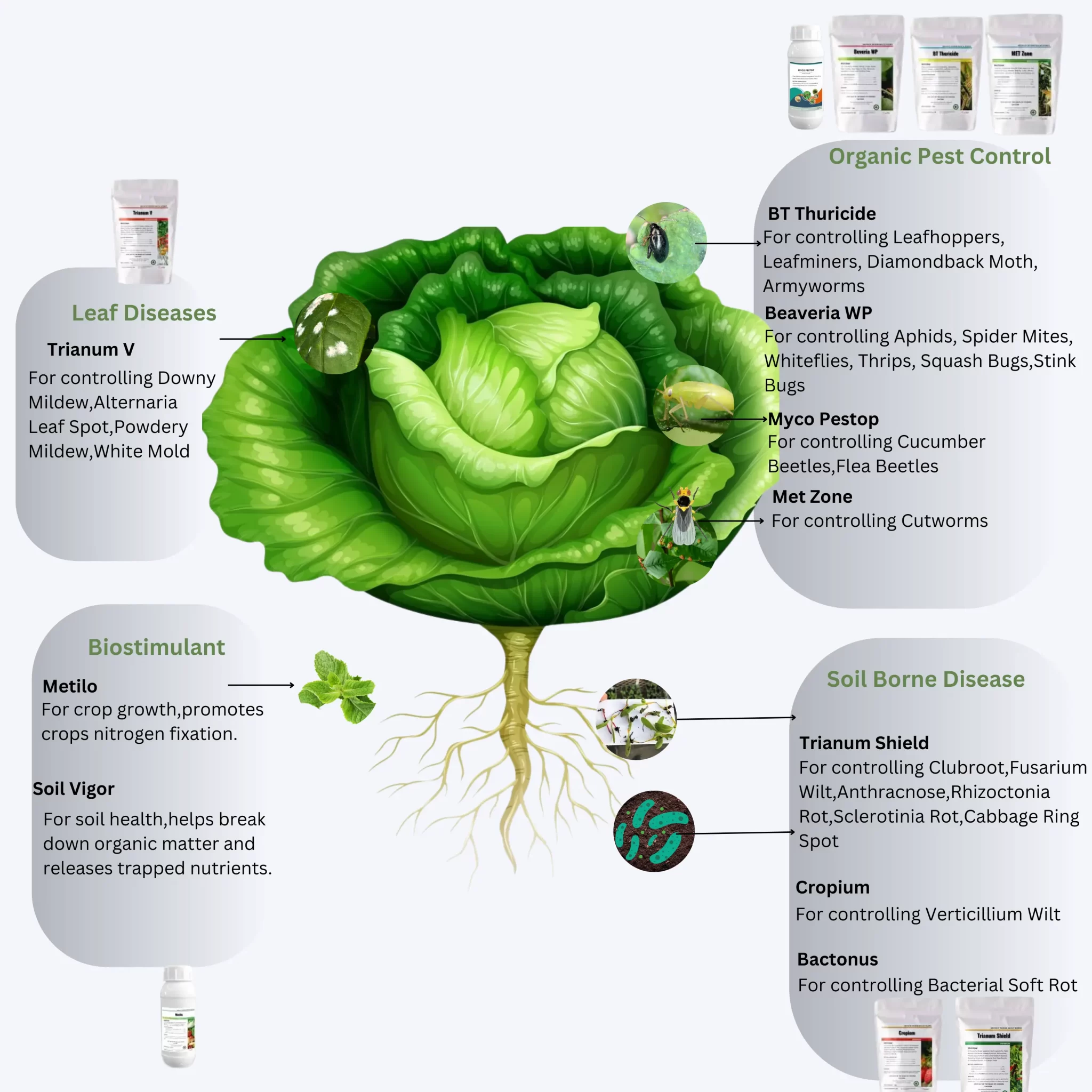
Related Products
CONTACT US

Office 38/1502, No 660,Hanguang Rt., Changsha City, Hunan, China




































